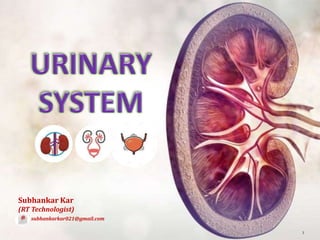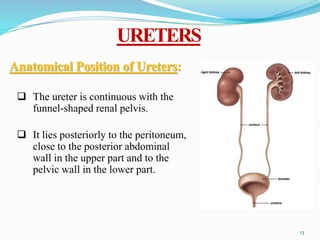Urinary System | RT Subhankar
- 2. CONTENTS 1. Introduction 2. Urinary System 3. Kidney ’é« Nephron ’é« Formation of Urine 4. Ureters 5. Urinary Bladder 6. Urethra 7. Diseases of Urinary System 8. Importance of Urinary System 2
- 3. INTRODUCTION ’ü▒ Urinary system is the main excretory System. It is also known as the Renal System or Urinary Tract. ’ü▒ The urinary system acts as a purification plant, clean blood and remove waste products from the body. 3
- 4. ’ü▒ Urinary system consist of 2 kidneys,2 ureters, urinary bladder and urethra. ’ü▒ After kidney filter the blood, they return mostof the water and other soluter to the blood stream. ’ü▒ The remaining water (urine), passes through the ureters and is stored in the urinary bladder. URINARY SYSTEM 4
- 6. KIDNEY Anatomical Position of Kidney: ’ü▒ The kidneys lie on the posterior abdominal wall, one on each side of the vertebral column, behind the peritoneum and below the diaphragm. ’ü▒ They extend from the level of the 12th thoracic vertebra to the 3rd lumbar vertebra, receiving some protection from the lower rib cage. 6
- 7. KIDNEY Structure of Kidney: ’ü▒ Each kidney is enclosed in a renal capsule, which is surrounded by adipose tissue, ’ü▒ Internally, the kidneys consist of a renal cortex, renal medulla, renal pyramids, renal columns, major and minor calyces, and a renal pelvis. ’ü▒ Blood enters the kidney through the renal artery and leaves through the renalvein. 7
- 8. KIDNEY i. Formation of urine ŌĆō The kidney form urine, which passes though the ureters to the bladder for storage period. ii. Excretion ŌĆō It excretes waste product, especially the nitrogenous and sulfur containing end products of protein metabolism. iii. Filtration ŌĆō This take place through the semipermeable walls of the glomerulus and glomerular capsule. iv. Tubular secretion ŌĆō Tubular secretion of hydrogen ions (H+ ) is important in maintaining normal blood pH. v. Electrolyte balance ŌĆō Changes in concentration of electrolyte in the body fluid may be due to changes in the body water or electrolyte level. Functions of Kidney: 8
- 9. NEPHRON ’ü▒ The nephron is the functional unit of kidney. ’ü▒ Nephron consists of a tubule closed at one end, the other end opening into a collecting tubule. ’ü▒ The closed or blind end is indented to form the cup-shaped glomerular capsule (BowmanŌĆÖs capsule), which almost completely encloses a network of tiny arterial capillaries, the glomerulus. ’ü▒ Continuing from the glomerular capsule, the remainder of the nephron is about 3 cm long and is described in three parts: ’é© The proximal convoluted tubule ’é© The medullary loop (loop of Henle) ’é© The distal convoluted tubule, leading into a collecting duct. 9
- 10. NEPHRON 10
- 11. i. It helps the body to get rid of the unwanted components. ii. It regulates the level of metabolites and electrolytes. iii. Nephron control the blood volume and blood pressure. iv. It also helps in the maintenance of blood pH. v. Nephron helps in maintain the salts, glucose, urea and other minerals in our body. FUNCTIONSOF NEPHRON 11
- 12. FORMATION OF URINE ’ü▒ The kidneys form urine, which passes through the ureters to bladder to for storage before excretion. ’ü▒ Urine consist of 95% of water & 5% of solid substances. ’ü▒ There are 3 processes involved in the formation of urine: i. Filtration ŌĆō water & solutes smaller than proteins are forced through the capillary walls & pores of the glomerular capsule into the renal tubule. ii. Reabsorption ŌĆō water, glucose, amino acids & irons are transported out of the filtrate into the cells and than enter the capillary bloods. iii. Secretion ŌĆō removes additional wastes from the blood and secreted by the tubule cells into the filtrate. 12
- 13. URETERS Anatomical Position of Ureters: ’ü▒ The ureter is continuous with the funnel-shaped renal pelvis. ’ü▒ It lies posteriorly to the peritoneum, close to the posterior abdominal wall in the upper part and to the pelvic wall in the lower part. 13
- 14. URETERS Structure of Ureters: ’ü▒ Each ureter is about 25-30 cm long with a diameter of about 3 mm. ’ü▒ The walls of the ureters consist of 3 layers of tissue: ’ā╝ Outer fibrous tissue ’ā╝ Middle layer consisting of interlacing smooth muscle fibers. ’ā╝ And an inner layer of mucosa. 14
- 15. URETERS Functions of Ureters: i. Ureters carry urine from kidney into urinary bladder. ii. Folds over ureters opening to stop urine from going back up. 15
- 16. URINARY BLADDER Anatomical Position of Urinary Bladder: ’ü▒ Urinary bladder is a reservoir for urine. It lies in the pelvic cavity and its size and position vary, depending on the volume of urine it contains. ’ü▒ When urinary bladder is distended, it rises into the abdominal cavity. 16
- 17. Structure of Urinary Bladder: ’ü▒ It is pear shaped, but becomes more oval as it fills with urine. ’ü▒ It opens into the urethra at its neck. ’ü▒ The bladder wall composed of 3 layers: ’é¦ Outer layer of connective tissue ’é¦ Middle layer consisting of interlacing smooth muscle fibers & elastic tissue. ’é¦ Inner mucosal layer. URINARY BLADDER 17
- 18. Functions of Urinary Bladder: ’ü▒ Urine, excreted from the kidneys, collects in the bladder before disposal by urination. ’ü▒ The urinary bladder usually can hold 300-350 ml of urine. URINARY BLADDER 18
- 19. URETHRA Anatomical Position of Urethra: ’ü▒ The urethra is a canal extending from the neck of the bladder to the exterior, at the external urethral orifice. ’ü▒ It is longer in the male than in the female. 19
- 20. URETHRA Structure of Urethra: ’ü▒ Male Urethra is associated with urinary and reproductive systems & has 3 main layers: muscle layer, submucosa and mucosa layer. ’ü▒ Female urethra is approximately 4cm long & 6mm diameter & its wall has two main layers: outer muscle layer & inner lining of mucosa. 20 (a) male
- 21. URETHRA Functions of Urethra: ’ü▒ In male, urethra helps in excretion of urine. ’ü▒ In female, urethra also carries urine from the bladder to outside of the body. 21
- 22. DISEASES OF URINARYSYSTEM ’ü▒ Urinary disorder is a condition that effect kidney, ureters, bladder, or urethra or that affect their function. ’ü▒ It includes cancers of urinary tract, incontinence interstitial cystitis, kidney stones, kidney failure & urinary tract infection. ’ü▒ It can be caused by cancer condition affecting the structure near the urinary tract, infection, inflammation, injury, nervous system disease, scarring and urine crystallization. 22
- 23. IMPORTANCE OF URINARY SYSTEM i. Remove toxic waste products from the bloodstream. ii. Excrete urine from our body. iii. Regulate blood volume. iv. Regulate electrolyte balance. v. Regulate acidŌĆōbase equilibrium. 23
- 24. 24
























